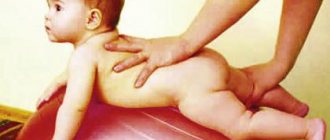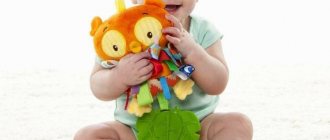When is it time to crawl?
According to scientific research, a fully developing child begins to crawl at six to seven months, sometimes a little later. However, some babies skip this stage of development. His parents believe that crawling is not necessary and are teaching him to use a walker. They assume that this way he will develop faster intellectually and physically. As a result, the baby begins to walk, bypassing the crawling stage. In addition, parents get used to the fact that the child should sleep on his back and during wakefulness they forget to turn him over onto his tummy.
As a result, he gets used to this position; when he turns over on his stomach, he begins to act up, and his mother returns him to his usual position. The muscles of the limbs, which should gradually become stronger, remain without training. And by the due date, at best, the child begins to crawl back or does not do this at all.
Child development in the fourth month
By the beginning of the fourth month, the symptoms of intestinal colic bother the baby much less often; almost all the time he is in a good mood, so he is even more interested in the world around him.
Development of speech skills
The baby's babbling gradually becomes more active, the child makes drawn-out vowel sounds. In addition, the sounds it makes become more varied. To stimulate the development of his speech skills, it is necessary to constantly pay attention to the child.
- Talk to him all the time and comment on your actions when feeding, dressing or bathing him. Point to interesting objects and describe them to your baby.
- Repeat the sounds after your child. Try to ensure that each of them is accompanied by distinct lip movements and active facial expressions. Soon the baby himself will repeat what you say.
- Ask someone else close to you to join in the conversation. Take turns saying a sound.
Despite the different sounds of the voices, the baby will learn to understand that you are repeating the same thing. Changing the timbre of your voice during such conversations will have a positive effect on the development of your child’s speech skills.
- By 4 months, the baby is already beginning to recognize his name and respond to it. Call him by his name as often as possible instead of using diminutives.
The baby laughs even more actively than before. He squeals with pleasure and reacts to tickling. Be careful not to overexcite your child during noisy games. This may frighten him and cause him to cry.
First peak of physical activity
The baby already knows how to roll over from back to stomach. Let's remember one of the main reflexes of a newborn - the crawling reflex: if you put the baby on his tummy, he will make crawling movements. Try to touch his feet with your palm - and the child will push off from it, accelerating. By four months, this reflex begins to fade, but if it is stimulated, then by five months your baby will be able to make the first timid attempts to crawl.
At the fourth month, the child already begins to reach out to the toy. Sometimes, reaching for it, he immediately clenches his hand into a fist and pushes the toy with his fist, without grasping it. If you put a toy in your hand, he will hold it for a long time, pull it into his mouth and then throw it. Only from the fifth month does the baby's reaching out and grabbing an object begin to resemble similar movements of an adult.
Looking at objects
By four months, a child can not just look at an object, but examine it in detail, and also move his gaze from one object to another. He can focus his vision depending on whether they are close or far away. The baby distinguishes colors even better, even to the point of understanding the difference between shades of the same color. He can also turn his head and look 180 degrees.
If a stranger approaches a child, the baby will first stop moving and babbling, then open his eyes wide and open his mouth frequently. This is an indicative reaction, which is most often followed by joyful revival, but the opposite reaction may also occur - fear and negativism. Well, by the age of five months, the baby will be able to clearly distinguish you from other adults with obvious differences in emotional reactions to your appearance and disappearance from his field of vision.
The material was prepared on the basis of the textbook “Propaedeutics of Childhood Diseases”, edited by Vorontsov I.M., Mazurin A.V. 3rd ed., additional. and processed - St. Petersburg: Foliant Publishing House LLC, 2009. - 1008 p.
Opinion of Dr. Komarovsky and B. Spock
It is quite difficult to say exactly at what month your baby will start crawling. However, if he knows how to roll over and likes it, he will soon try to move around. B. Spock claims that babies begin to learn this process at five or six months, and crawl quite well by seven months. At the same time, they have different ways of crawling. In some families, already at four or five months the child is crawling backwards, in others - immediately on all fours, but this happens later, at seven or eight months. Nevertheless, both are considered the norm.
Pediatrician E. Komarovsky believes that the child himself knows and decides when to sit, crawl and walk. And parents should not interfere with this; it is their duty to ensure that these processes bring joy to the child and are not hard work.
The formation of a child’s motor activity is influenced by:
- psychological atmosphere in the family;
- personal and physical characteristics of the baby;
- his state of health.
In other words, crawling is a certain stage of development that some babies skip and go straight to walking. However, this is also a variant of the norm.
Hearing.
At 4 months, the child’s hearing becomes more developed, and the child begins to distinguish between the voices of mom and dad. Hearing a familiar voice, the baby will look for where the sound is coming from. It is necessary to include rhythmic music for your baby, since music at this age has a beneficial effect on his development. The baby begins to remember frequently repeated words and even tries to display them in his own way. It is necessary to communicate with the child as much as possible and tell him even the simplest things. It is recommended to read a lot of books to your child, and reading with intonation and reading with different voice timbres will be better for his perception.
Do you need to learn to crawl?
You should not force the baby to lie on his stomach, but gradually it is necessary to accustom him, preparing him for crawling. After all, this is a very important period not only for physical development, but for the subcortical structures of the brain. In particular, brain dysfunction, which is a consequence of difficult childbirth or birth trauma, is compensated to some extent during the crawling period. During this activity, the baby strengthens the musculoskeletal system, trains the arms, shoulders, elbows and wrists. Therefore, crawling children are more physically developed than infants who missed this stage. Training the ligaments of the wrists and hands is useful for the development of fine motor skills.
Such kids will quickly learn to hold a spoon and pencil correctly. In addition, while crawling, the child learns to navigate in space and control the body. Therefore, the crawling stage is useful and important and should be encouraged and supported. If your heir independently chose his crawling style, then it is better not to interfere with him, advises pediatrician E. Komarovsky. Whether the child crawls backwards or using one leg - it doesn’t matter, he is fulfilling his individual development program. During this process, the baby develops his first spatial orientation skills.
Signs of scoliosis
As a rule, parents begin to worry when they notice signs of scoliosis much later—at the age of 6–7 years. And with each subsequent year, scoliosis progresses along with the growth of the child’s skeleton. Rapid growth occurs during adolescence, and accordingly, scoliosis actively progresses, provoking the development of many concomitant diseases. Since the spine is connected to the entire body, its change (in this case, scoliosis) can affect a number of important processes, which will cause a lot of inconvenience for an adult.
For example, the consequences could be:
- different leg lengths;
- fatigue when walking;
- asymmetrical position of the child’s feet;
- valgus deformity of the feet.
Such violations have a significant impact on the quality of life, causing in turn other negative consequences. As a result, a person’s physical condition becomes very far from normal.
It is difficult to call the owner of such features completely healthy, although this is “only” flat feet... While performing this or that work, a person may feel discomfort and get tired quickly. So the expression “comes from childhood” is directly related to this topic.
The child crawls but does not walk: a reason to urgently consult a doctor / istockphoto.com
Why does the baby crawl backwards?
He can do this:
- Consciously. For example, I saw my mother mopping the floors and moving backwards, or I spied on older children playing.
- Forced - he tried to crawl forward, but his arms turned out to be weak, he fell and hit himself.
- Intuitively, the child’s body understands that some muscles need to be protected, while others can be relied upon. Crawling backwards, the baby spends less energy.
According to pediatricians, this is not dangerous and the baby does not have any pathology. However, if the baby does not attempt to crawl forward after two or three months, then it is recommended to evaluate his muscle strength. In some cases, the reason lies in muscle hypertonicity or hypotonicity.
So, if a baby crawls backwards for a long time, then corrective gymnastics is necessary, since moving in one direction does not allow all muscle groups to develop.
The child began to crawl backwards: pros
Let's look at the positive aspects of this skill:
- The increase in muscle load occurs gradually. Moving around thanks to the push is quite easy. The development of joints and the development of the vertebral sections occurs without any unpleasant sensations for the baby.
- It turns out that teaching a baby to crawl backward is more difficult than teaching it to crawl forward. In addition, during this movement, muscle groups work that are not involved when moving forward.
- According to scientists, with this method of movement the vestibular apparatus is trained.
Learn to crawl correctly
The child crawls backwards, but how to teach him forwards and is it possible to do this? First of all, you need to be patient. It takes a certain amount of time for a child to learn a new skill. The following recommendations will help you cope on your own:
- It is necessary to evaluate the quality of the surface on which the child moves. The surface should be pleasant and not slippery.
- Place his favorite toy in front of him and let him reach for it. However, you should not help him in this case.
- Encourage and praise your baby when he crawls correctly.
- Show by example how to move.
The most important thing is that the baby has fun and interesting learning to crawl forward, and this requires devoting a lot of time to such activities.
Russian medical standards
In accordance with these standards, the baby must master the technique of crawling at six to seven months, i.e. during this period he tries to make his first movements. This stage is preceded by the ability to roll over onto your tummy and hold your head up. Initially, the baby tries to crawl on his tummy, since he does not yet know how to move his legs. The entire load falls on the muscular system of the upper limbs. Then he begins to understand that he can also use his legs - push off with them or pull up.
During this period, some babies begin to crawl in different ways. After a short period of time, the little one already feels confident and moves freely. Sometimes he does it backwards, and worried mothers ask doctors what to do if the baby crawls backwards? Most children will begin to crawl in the right direction after some time and no further action is required. In case of hypo- or hypertonicity, special gymnastics will help, with the help of which the muscles are strengthened.
Dr. Komarovsky: how to teach a child to crawl?
Evgeniy Olegovich Komarovsky tirelessly repeats the benefits of crawling as opposed to early disembarkation or staying in special devices that put the child in an upright position (for example, walkers). However, he calls all accepted standards regarding when a child should sit, crawl or stand on his feet as deeply exemplary. Thanks to this doctor, young mothers, having listened to all-knowing people around them, realized that the child does not owe anything to anyone.
When the time comes, he will crawl, when his muscles become stronger, he will sit down, when he is ready, he will stand up. Komarovsky's statements are always based on common sense. He notes that a distinctive feature of a person is upright posture, which, however, brings with it diseases such as radiculitis and scoliosis. Therefore, early premature load on the spine leads to the fact that it does not have time to fully strengthen.
The later the child gets on his feet and walks, the stronger the spine will be; the more actively the child crawls, the stronger the back muscles will be.
The child will learn to crawl - with or without your help, the main thing is to encourage him in this matter and remember: the more, the better.
Crawling is a very desirable phase in a child's development. Each baby begins to crawl at a different time and in different ways. And some people don’t crawl at all or suddenly start crawling after they’ve started walking. In any case, do not limit the child to the crib or playpen area, give him the opportunity to actively grow. It is very important not just to teach a child to crawl, but to systematically devote a lot of time to this movement.
Importance and benefits of baby crawling
Crawling develops a sense of equilibrium, balance, and strength. In addition, this important stage forms and strengthens the baby’s emotional, visual understanding, and motor skills. So, thanks to crawling:
- Motor skills and the ability to make small and precise movements appear. When crawling, all muscle groups work, motor-visual coordination is developed, and the ability to control the small muscles of the body is established.
- The spine is fixed and aligned. When a baby begins to crawl, he not only learns to control his limbs, but also develops a muscular system that strengthens the spinal column.
- Visual perception, brain, and vestibular apparatus develop. While crawling, the toddler uses binocular vision, as a result he develops a reaction that will be useful in the future for reading and writing skills. During such movement, the vestibular apparatus also develops, helping to improve balance. When crawling, motor nerve impulses switch places between the two hemispheres at tremendous speed. This promotes the development of neurological skills.











